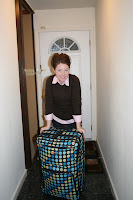October 04, 2005
The truth behind the Singing ButlerBy David
Lister, Scotland Correspondent
IT IS the bestselling print in Europe, more popular than Monet’s Water Lillies or
Van Gogh’s Sunflowers, and
has helped to amass a multimillion-pound fortune for the man
who painted it.
But Jack Vettriano, the self-taught artist whose
stylised depictions of lovers, butlers and girls in polkadot dresses
are reproduced on everything from cards to mouse mats,
admitted
yesterday that his most iconic
picture, The Singing Butler, was inspired by a cheap artist’s
manual.
For years the art establishment has shunned
Vettriano, triggering accusations of
snobbishness by claiming that the
former miner cannot paint, but just colours in.
To the
glee of the art elite, Vettriano’s agent has had to admit that some of his most
famous
pictures were based on pictures in a
£16.99 reference book.
Tom Hewlett, the director of the
Portland Gallery, which acts for Vettriano, did not even
attempt to deny the obvious
similarities between images in The Illustrator’s Figure
Reference Manual and Vettriano’s
paintings after a Scottish newspaper announced that it
had uncovered “Jack’s
secret”.
Mr Hewlett said: “It is widely known that Jack
is a self-taught artist and it seems
unsurprising that as, in his early
painting years he had neither time nor the money at his
disposal to work with real-life models,
that he should use a teaching manual such as this.”
He added: “Vettriano’s skill lies in his ability to create narrative paintings
with which the
viewer becomes involved.
“He is a master of generating atmosphere in his paintings
and bringing to life the characters
within them. In this way he transforms
mundane characters into extraordinary ones and
everyday scenes into special
occasions.”
The Singing Butler, the original of
which sold for nearly £750,000 at auction last year, bears
a surprising likeness to a
series of figures in The Illustrator’s Figure Reference Manual,
which cost £16.99 in 1987, the year
Vettriano took up painting.
The manual also
contains several other images, published in the Daily Record yesterday,
that bear an uncanny resemblance
to Vettriano’s paintings Dance Me To The End of Love,
Waltzers and Elegy for the Dead
Admiral.
Vettriano’s work has been bought by a
range of celebrities including the Hollywood star Jack
Nicholson, the Scottish comedian
and actor Robbie Coltrane and Sir Alex Ferguson, the
Manchester United manager.
His images are so popular that he has been dubbed
“the people’s painter”.
He started to dabble with
art after his girlfriend bought him a painting set in the 1980s and
has been studiously ignored by
the major galleries and exhibitions, even in his native
Scotland, where the Kirkcaldy Museum
and Art Gallery in Fife is the only one to own his
work.
In an interview last year Vettriano, 53, who makes about £500,000 per year
from
royalties, said of The
Singing Butler: “It was one of these paintings I ought not to have
been able to do.
“It was like I cheated. It was 1992, I was hardly
in the back door of the art world when I did
it. Now we all get fed up seeing
it.”
Richard Demarco, a fellow Scottish artist and
an honorary member of the Royal Scottish
Academy, said that it was
irrelevant whether Vettriano used the book or not.
He said: “The figures in the book are not art. He has used that useful
information to turn a
lady in a
dress into a maid, two figures dancing into two lovers. He has given them emotion.”






























 Well, I suppose I should get supper started. I think I am going to saute some shrimp and toss onto a caesar salad. Sounds good and quick!
Well, I suppose I should get supper started. I think I am going to saute some shrimp and toss onto a caesar salad. Sounds good and quick!

